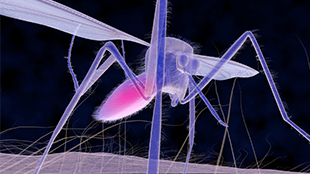Review of Chief Complaints and Discharge Diagnoses of West Nile Virus (WNV) Disease Cases to Improve WNV Surveillance, Florida 2020
Updated May 23, 2023

In 2020, Florida had its third-highest number of reported cases of West Nile virus (WNV) disease. Diagnosis is challenging because the symptoms are not specific and can look like other diseases. The Florida Department of Health recognized the need to detect West Nile virus early at hospitals where people seek care.
The Florida Department of Health compared reported disease cases with automated, electronic health data from emergency department visits. They focused on information in the patient’s chief complaint and the clinician’s discharge diagnosis.
Their findings suggest that searching emergency department data can help identify unreported WNV disease. They also identified potential enhancements to make the WNV disease definition more useful when querying data.
Public Health Problem
In 2020, Florida experienced increased West Nile virus (WNV) activity resulting in the third-highest number of reported cases on record in the state. WNV disease case identification is challenging because symptoms can be nonspecific and mimic other health conditions. The Florida Department of Health sought to improve the existing definitions used to search emergency department data, thereby increasing the likelihood of detecting WNV.
Actions Taken
The Florida Department of Health reviewed 2020 WNV disease case records (confirmed and probable) to identify commonly reported chief complaints (CCs) and discharge diagnoses (DDs). Medical records uploaded to Florida’s reportable disease surveillance system were used to determine CCs and DDs of WNV disease cases meeting the Council of State and Territorial Epidemiologists’ current case definition. Commercial testing of all reported cases was confirmed at a reference laboratory. The CCs and DDs identified in medical records were compared to those in Florida’s syndromic surveillance system, the Electronic Surveillance System for the Early Notification of Community-based Epidemics (ESSENCE–FL).
Outcome
Of the 46 WNV disease cases, 39 patients had medical records available for review. Of those, the most common CCs were fever (59%), weakness (33%), and altered mental status (AMS; 28%). Additionally, one patient (3%) presented with CC of falls. The most common DDs were fever (54%), AMS (33%), meningitis (33%), encephalitis (28%), and weakness (21%). Two patients (5%) had falls listed as DDs. Only five patients (13%) had DDs that included WNV. Additionally, one patient not initially diagnosed with WNV disease was identified through ESSENCE–FL based on the reported symptoms (meningitis and AMS). Other DDs included sepsis (15%); urinary tract infections (5%); and kidney (13%), pulmonary (8%), and cardiac (5%) issues. ESSENCE–FL listed more DDs than were found in the medical records, perhaps due to updates over time. These findings suggest that by searching emergency department data and by refining the queries, the Florida Department of Health can identify unreported WNV disease.
A review of CCs of patients presenting with the following symptoms may be useful for detecting WNV disease: fever and weakness; fever and AMS; fever, weakness, and AMS; and DDs of fever with AMS, meningitis, encephalitis, or weakness, potentially in conjunction with patient age. In addition, DDs provided information not captured in the medical records provided to the health department.
Contact
Multi-County Epidemiologist
Florida Department of Health in Levy County
Andrea Morrison, PhD
Vector-Borne Disease Surveillance Coordinator
Florida Department of Health
Division of Disease Control and Health Protection
Bureau of Epidemiology
Email: Andrea.Morrison@flhealth.gov
Office of Public Health Data, Surveillance, and Technology
www.cdc.gov/nssp
This success story shows how NSSP
- Improves Data Representativeness
- Improves Data Quality, Timeliness, and Use
- Strengthens Syndromic Surveillance Practice
- Informs Public Health Action or Response
The findings and outcomes described in this syndromic success story are those of the authors and do not necessarily represent the official position of the National Syndromic Surveillance Program or the Centers for Disease Control and Prevention.
